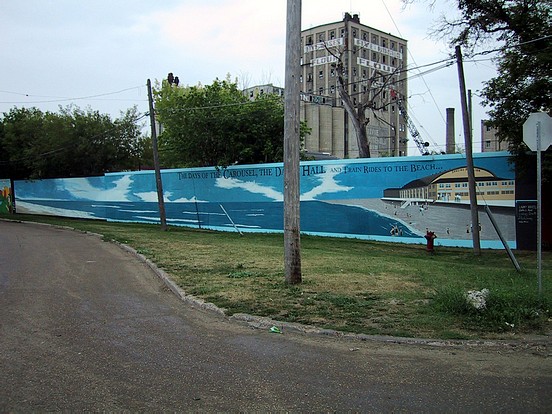|
|
|
|
18 Sutherland Avenue (2)

This Mural was began and initially completed in 2002 (see photo 2) and then the scene extended in 2003 to the final full panoramic wall seen here. The rendering artists were Larry Bartley, Mark Remoquillo, Lloyd Swampy and Earl Ross; with extra help from painters Lloyd Swampy Jr., Stephan Swampy, Lindsay Grant and Michael Moisan. Sponsorship for this project was provided by Take Pride Winnipeg and Neighbourhoods Alive. The artwork was lost when the long fence was completely replaced in 2013.
Original notes follow:===
Grand Beach is one of the largest and most famous beaches in North America. The area’s natural beauty and close proximity to Winnipeg made it a great vacation spot. In 1914, the Canadian Northern Railway Company developed the resort site. There was a train station, hotel, ice house, a beautiful Carousel building, and the Dance Pavilion. Daily passenger service was offered starting in 1916 with ten coaches that could transport 500 people. At its peak of popularity, trains ran every half hour. It is said that on the Wednesday that the Caterers Picnic was held at Grand Beach, Winnipeg grocers would actually close shop when up to 10,000 people would leave Winnipeg to attend the picnic.
The Dance Pavilion itself was built in 1917, and unquestionably became the entertainment centre of the entire resort for decades. Due to the popularity of the Pavilion, an evening train service called the ‘Moonlight Special’ was offered, leaving Winnipeg for the pavilion at 6:15pm; and then leaving Grand Beach at 11:50pm. Return fare was 50 cents.
This Mural was commissioned partly because there was a problem with graffiti at this site. The original sixty-foot scene was completed in 2002 with Larry Bartley and Mark Remoquilla (see photo 2) and in 2003, the decision was made to extend and expand the scene by painting the remaining 100 feet of unpainted wall.
Larry Bartley: “One scene that hadn't been done so far was a beach scene. The historical
theme of the Grand Beach Dance Pavilion, which, by interest, was the only Provincial Park that turned a profit during the Depression years. The dance pavilion was very popular and very accessible from Winnipeg-you could hop on a train and it would take you right out there. I went to the archives and found some pictures of the beach, dance pavilion, people dancing in the pavilion and people disembarking from the train at Grand Beach. I put the pictures together and made a composition and then I had it converted by a graphic designer into colour (back in those days the pictures were in black-and-white).”
“I approached Manitoba Arts Council for a mentor aboriginal grant that would allow a professional aboriginal artist (Lloyd Swampy) to take under his wing an emerging aboriginal artist (Earl Ross). My job as project manager was to take on students from the Seven Oaks School Division and work with them on the beach scene, the pavilion and the people. It's a summer school arts course project that the kids receive credit for.”
“The pavilion burned down in the fifties (Labour Day weekend, 1950) and unfortunately was never rebuilt. It was a very popular spot for people to come to. Dances admission back then was five cents for a couple. People would get dressed up in their nicest Sunday clothes and go and pack the place! It was a vast, huge pavilion. Thousands of people could be dancing, and there'd be a 12 or 14 piece orchestra playing. Legend also has it that at least one child was conceived under the boardwalk at Grand Beach!”
Several passers-by would suggest to Larry that more “things” be added to the scene, be it boats, skidoos, windsurfers, swimmers, etc., but Larry was insistent that he wanted an uncluttered look and that such additions would deter from depicting the vastness and the raw, pure pristine feel of Grand Beach.
Painters: Lloyd Swampy Jr., Stephan Swampy, Lindsay Grant, Michael Moisan
|
Displaying Photos 1-3 of 3
|
|